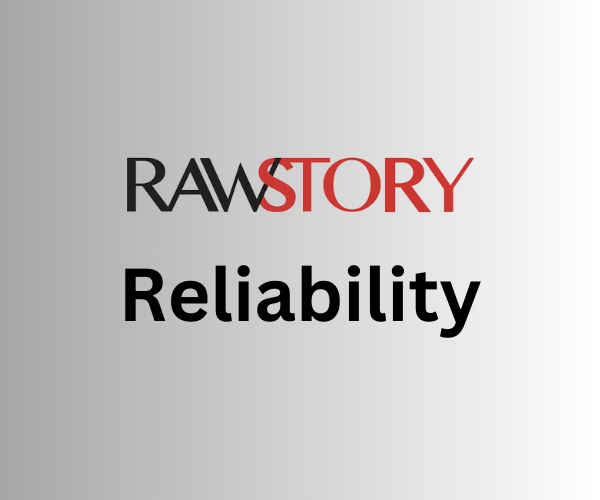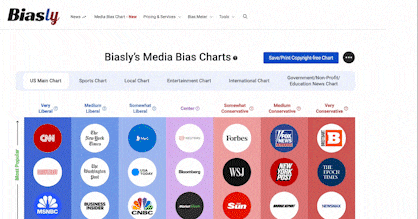
For many years, Raw Story has dedicated itself to investigative journalism and breaking news from a progressive perspective. Their reporting has shed light on various political and social issues, often sparking important conversations and highlighting stories that might be forgotten. Raw Story has played a significant role in fostering a more informed and engaged public by emphasizing transparency and accountability. However, Raw Story has been criticized for misinformation regarding its reporting accuracy, with articles often containing inaccuracies or being misleading.
At Biasly, we strive to evaluate the reliability and accuracy of all media outlets. Let us investigate the reliability and accuracy of Raw Story.
Does Reliability Matter?
Reliability, in general, refers to how trustworthy or accurate information, or in this case, a news source is. If we consider this definition, it quickly becomes clear why reliability is important in media sources. If we can’t trust the things we read then there isn’t much of a point in continuing to consume content from that source, after all. So how exactly can we gauge the reliability of a news source anyways?
There are several potential measures of reliability to look out for when trying to determine whether a media source is reliable or not. Red flags for an unreliable article can include the presence of wild unsubstantiated claims, facts dependent on other unreliable sources, heavy use of opinionated language, and more. Some indicators of a reliable news source, on the other hand, include things like:
- Absence of subjective/opinionated language in articles
- Credible sources cited (e.g., neutral sources, .gov, .edu websites)
- Facts and statistics backed by multiple relevant outside sources
- Use of primary sources when possible (e.g., interviews, quotes)
- Information that remains consistent across news sources
How Does Raw Story Fare in its Reliability?
The political reliability index developed by Biasly objectively assessed news organizations’ accuracy and trustworthiness. Raw Story’s overall Reliability Score has been rated as ‘Fair’ by Biasly. This rating is a weighted average of two distinct scores: the Fact Analysis Score and the Source Analysis Score, each evaluating separate components of Raw Story’s Reliability.
When computing the Average Reliability of the article, the Fact Analysis score is more heavily weighted. These ratings are as follows in the next two paragraphs:
Raw Story’s Fact Analysis Score is ‘Fair’, which suggests readers can trust most of Raw Story’s content online. The Fact Analysis score focuses more on the accuracy of claims, facts, and sources presented in the article and any hints of selection and omission bias, which we will discuss further in the article.
Raw Story’s Source Analysis Score is ‘Fair,’ which suggests readers can trust some of the sources, links, and quotes provided by the news source. This score, which is based on A.I., focuses on assessing the quality of sources and quotes used, including their number, lengths, uniqueness, and diversity.
However, since these scores are based on percentages and averages, individual articles could be more or less trustworthy depending on the context, author, and other factors. Our findings show that Raw Story’s reliability is mostly but not all factual because it has retracted several stories in the past and published articles with unverified sources.
Let’s analyze the supporting data for Raw Story’s rankings and discuss what to look for when searching for trustworthy news sources.
Raw Story’s Accuracy and Reliability
Raw Story is recognized for its progressive perspective, which may lead to potential biases in its reporting. The outlet frequently highlights stories that support liberal viewpoints, which can result in selective coverage or biased framing of issues. At Biasly, we will evaluate the credibility of news stories from Raw Story by assessing the quality of the sources, the accuracy of the reporting, and any potential bias present in the articles.
Selection bias is when stories and facts are selected or deselected, often on ideological grounds, to create a narrative supporting the new sources’ ideology. Omission bias, on the other hand, is when different opinions and political views regarding a situation are left out so that the reader is only exposed to the ideological perspective supported by the author. It’s essential to keep in mind these two types of biases when trying to assess an article’s level of accuracy.
Biasly assigns a percentage score to accuracy, with one being the least accurate and 100 being the most. Ratings are calculated by weighing assertions with supporting evidence, the number of reliable internal sources, and the number of reliable external sources employed. A full page at Biasly’s website includes dependability and accuracy ratings for newly released Raw Story news stories. According to the reports that analytics have assessed, Raw Story has a ‘Fair’ reliability score. This score can vary from article to article, though, and the most extreme variations in dependability are caused by bias, notably omission and selection bias.
We will examine more examples to investigate the reliability of articles from Raw Story. This analysis will focus on selection bias, omission bias, and the quality of the sources and facts presented.
Analysis of Reliability in Raw Story Online Pieces
Raw Story’s online articles are recognized for their progressive and left-leaning perspective, often highlighting political topics and social justice issues. While it offers a platform for alternative viewpoints, some critics argue that it occasionally lacks thorough fact-checking and may present information with a partisan bias.
Like other news outlets, Raw Story features an Opinion section presenting a range of viewpoints, which may not always align with the publication’s overall stance. This section invites contributors from diverse backgrounds and ideologies to share their insights, fostering a space for healthy debate and discussion. Readers can find articles that challenge mainstream narratives and provide unique perspectives on current events. This diversity of opinions enriches the discourse and encourages readers to consider multiple sides of an issue.
Quality of Sources and Facts Used
Raw Story has been criticized for inaccuracies in its reporting, with some articles labeled as misleading. The spread of misinformation can erode trust in media outlets, making it challenging for audiences to differentiate between credible and unreliable sources. This loss of trust can contribute to spreading false narratives and misinformation, further polarizing public opinion.
For example, “Using Fox as a staffing agency’: Trump attacked over latest Cabinet hire” by Jessica Corbett. The article received an “Excellent” Rating for using Multiple Sources. Corbett included 12 quotes of varying lengths: two are short, and ten are long. In terms of multiple sources, the article lists eight references:
- CNN (Very Liberal)
- Raw Story (Medium Liberal)
- AP News (Somewhat Liberal)
- Common Dreams
- Truth Social
- Media Matters for America
- X (Twitter)
- League of Conservation Voters Scorecard
Stoehr’s selection bias is evident in his reliance on sources that primarily reflect liberal viewpoints, such as The Bulwark and a Democratic pollster. By focusing on these sources, he may convey a narrative highlighting the influence of right-wing media, potentially strengthening his argument about the role of conservative media in the election outcome. The author neglects to include sources and perspectives that could highlight other factors influencing the outcome of the 2024 election, such as economic issues and voter turnout. As a result, readers may come to believe that right-wing media was the only determining factor rather than one of many influences at play.
Another example is “’Tremendous and well-liked’: Trump taps another Fox TV host for Cabinet position” by Daniel Hampton. The article received an “Excellent” Rating for using Multiple Sources. Hampton includes eight quotes of varying lengths: four short, three medium, and one long. In terms of multiple sources, the article lists four references:
- Raw Story (Medium Liberal)
- Truth Social
- ABC News (Somewhat Liberal)
- Milwaukee Journal Sentinel
Hampton attempts to provide a balanced perspective by including sources with different political leanings, such as ABC News and the Milwaukee Journal Sentinel. Yet, it also poses the challenge of verifying the accuracy and reliability of each source. Raw Story, with its liberal bias, may present information in a way that favors one perspective, which could lead to the dissemination of misinformation if not critically evaluated. Readers must be cautious and actively cross-reference these sources to ensure that the information presented is accurate and not skewed by any inherent bias.
The selection of sources can significantly influence how information is framed and interpreted. When an article primarily relies on liberal-leaning sources, it may unintentionally emphasize perspectives that align with a particular ideological stance, potentially neglecting or diminishing opposing viewpoints. This selective focus can contribute to the spread of misinformation by presenting a narrative that seems comprehensive but is biased due to the lack of balanced representation.
Selection and Omission Bias
Raw Story is a publication known for endorsing a liberal ideology and seeks to influence its audience with that specific agenda. However, its Opinion Section features a variety of viewpoints, allowing readers to engage with perspectives that may not align with the publication’s overall stance. Biased articles often present information selectively, emphasizing specific facts while downplaying or ignoring others to support a particular narrative.
Let us examine an opinion article from Raw Story, “Until there’s a liberal media apparatus, the Democrats will live in Trump’s America” by John Stoehr, which is rated as centered. The article explores how right-wing media and attack advertisements influence the outcome of the 2024 election. It particularly examines the impact of the numerous accusations directed at Kamala Harris and the media’s role in shaping the political landscape.
The sources listed in the article include The Bulwark, a Democratic pollster, and media expert Matthew Sheffield.
“According to a new study by a Democratic pollster, Trump’s attack ads largely explain the outcome of the election.”
“…the substance of what she said could not be heard through the din of the rightwing media apparatus. ”
“ the final weeks of the election, the Trump campaign spent more than $29 million on television ads attacking Harris on trans rights. …making that topic their fifth-most emphasized.”
Stoehr’s selection bias is evident in his reliance on sources that primarily reflect liberal viewpoints, such as The Bulwark and a Democratic pollster. By emphasizing these sources, he may present a narrative that underscores the impact of right-wing media, potentially reinforcing his argument about the influence of conservative media on the election outcome. However, there is an omission of sources or viewpoints that might suggest other factors that played a significant role in the election outcome, such as economic issues or voter turnout, thus skewing the reader’s understanding of the situation. This absence of diverse perspectives can lead readers to believe that right-wing media was the sole determining factor rather than one of many influences.
Let us examine another opinion article, “Trump’s ‘first buddy’ is in deep, you-know-what,” by Robert Reich, which is rated as centered. The article is about the potential candidates for Trump’s Treasury Secretary position, the influence of Elon Musk in the decision-making process, and the implications of the choices for economic policies and democracy.
The sources listed in the article are The Wall Street Journal and X.
“Lutnick had been in the lead but a few days ago, according to the The Wall Street Journal, he heard from Trump’s allies that he might not get the nod.”
“Bad enough that Musk broke this basic rule. He went even further, publicly encouraging his nearly 205 million followers on X to weigh in, in favor of Lutnick.
Reich’s selection bias is evident as it heavily centers on the actions and potential consequences of Elon Musk’s public advocacy for Howard Lutnick to be selected for Treasury Secretary. This bias could compromise the audience’s understanding of the issue by concentrating exclusively on Musk’s influence and actions while neglecting other important factors in the selection process. The article fails to address the complexities of internal political dynamics and the qualifications of other candidates. Consequently, it may lead readers to form opinions based solely on Musk’s involvement rather than a comprehensive understanding of the candidate’s capabilities and potential impact on economic policies.
Both articles illustrate how selection and omission bias can influence public perception by highlighting specific narratives while overlooking others. These biases can cause readers to develop distorted viewpoints as they are not given a thorough analysis of all relevant factors. Consequently, the audience may form opinions based on incomplete information, which can lead to a polarized and misinformed public discourse.
So, Is Raw Story Reliable?
Raw Story is a progressive platform that adheres to a particular political ideology, which may influence their reporting and editorial choices. This makes it essential to consider the potential bias in its reporting, as it may emphasize stories that align with progressive values while downplaying or omitting opposing viewpoints. To gain a comprehensive understanding of current events, it is essential for media consumers to critically evaluate the sources they rely on and remain open to various perspectives. This approach enables individuals to navigate the complexities of the modern media landscape and form well-informed opinions. To assist with this, you can use Biasly’s News Bias and Reliability Checker to assess the reliability and credibility of your news sources.























